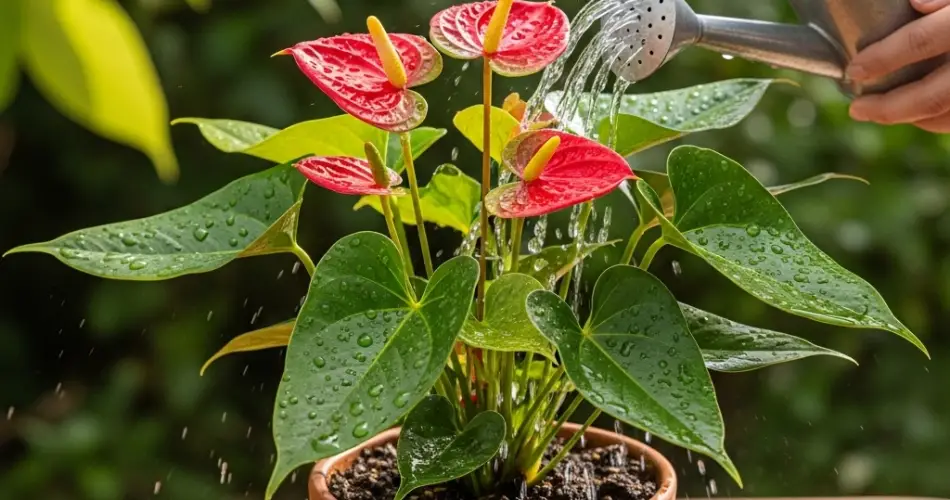Anthuriums are popular indoor plants, loved for their glossy green leaves and long-lasting, heart-shaped flowers in vibrant shades of red, pink, white, or purple. But while they’re relatively low-maintenance, watering mistakes are one of the fastest ways to cause problems with these tropical beauties.
Whether it’s drooping leaves or fading blooms, improper watering can quickly show up in your plant’s appearance. Knowing the difference between signs of overwatering and underwatering can help you adjust care before the plant suffers long-term damage.
Here’s a detailed guide to help you identify whether your anthurium is receiving too much or too little water—and what you can do about it.
How Much Water Do Anthuriums Need?
Anthuriums are native to warm, humid rainforests where they grow in rich but well-draining soil. In pots, they prefer consistent moisture but hate soggy conditions. The key is to water when the top inch of soil feels dry while ensuring excess water can escape through drainage holes.
On average, watering once a week is suitable for indoor anthuriums, but this can vary depending on humidity, light levels, temperature, and potting mix.
Signs of Overwatering Your Anthurium
Overwatering is the most common mistake made with anthuriums. Too much water leads to root rot, a fungal issue that slowly suffocates the roots, preventing them from absorbing moisture or nutrients.
Here are the warning signs of overwatering:
1. Yellowing Leaves
The lower leaves turning yellow is often the first symptom. It means the roots are stressed and struggling to function properly. If you notice several yellow leaves at once, check your watering schedule.
2. Mushy Stems or Roots
If the base of the stems feels soft or the roots are mushy and brown instead of firm and white, you’re dealing with rot caused by overwatering.
3. Wilting Despite Wet Soil
Paradoxically, an overwatered plant can still look wilted. This happens because the damaged roots can’t take in water properly anymore, leaving the plant dehydrated even in wet conditions.
4. Fungal Growth or Mold
Mold on the soil surface or a musty odor is a red flag that the potting mix is staying too damp. This environment encourages fungal issues and root rot.
5. Flower and Leaf Drop
If your anthurium is shedding leaves or flowers soon after forming them, and the soil is constantly wet, it’s likely getting too much water.
Signs of Underwatering Your Anthurium
While these plants don’t like wet feet, they also won’t tolerate extended periods of dryness. Allowing the soil to completely dry out between waterings can cause stress and visible symptoms.
Here’s what to watch for:
1. Dry, Crispy Leaf Edges
Browning at the edges or tips of the leaves—especially when paired with a very dry potting mix—is a typical sign your anthurium needs more water.
2. Curling or Drooping Leaves
When deprived of water, leaves may start to curl inward or droop. This is the plant’s way of conserving moisture, and it typically improves soon after watering.
3. Slow or No Growth
If your plant isn’t producing new leaves or flowers during the growing season, it may not be receiving enough water to support active growth.
4. Shriveled Roots
Roots that appear dry, thin, or brittle are a clear sign of prolonged underwatering. At this stage, the plant is seriously stressed.
How to Find the Right Watering Balance
To keep your anthurium happy, focus on striking a balance between keeping the soil moist—but never soggy.
Tips for Proper Watering:
-
Use your finger to check moisture: water when the top 1–2 inches of soil feel dry.
-
Always use a pot with good drainage to prevent water from pooling.
-
In warmer months, you may need to water more frequently, while cooler months typically call for less frequent watering.
-
Use a lightweight, well-draining mix with ingredients like orchid bark, peat, and perlite to help moisture move through the soil.
-
Avoid letting the plant sit in a saucer of water for extended periods.
Also, consider the plant’s environment. A plant placed in bright, indirect light and higher humidity will likely use water more efficiently than one in a darker or drier spot.
Final Thoughts
Anthuriums are stunning and resilient houseplants, but watering them incorrectly can quickly lead to trouble. By learning to recognize the signs of overwatering—like yellowing leaves and soggy soil—or underwatering—like crispy edges and leaf curl—you can take quick action to restore balance.
A well-watered anthurium will reward you with healthy leaves, bold blooms, and strong growth year-round. It all starts with understanding the plant’s natural preferences and responding to what it tells you.



